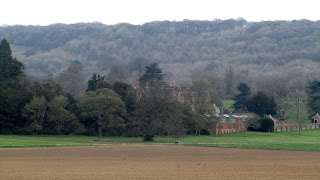A midweek day off work and chance to catch up on one of my 'missing legs from the 'Ridgeway'.
Today would be about covering as much of the 'Ridgeway' as possible. So no circular route on this occasional , purely linear.
Starting point is 'The Plough' at Lower Cadsden. I was a bit later than
planned due to traffic problems. The aim being to get to to the other
side of Wendover at least , then see how far I get. Allowing for a walk back of 2.5 hours.
The Ridgeway climbs immediately up Pulpit Hill and the Nature Reserve.

The weather is dry and a little overcast, a shame really as I left home in bright sunshine. Hopefully things will brighten up as I go along.
It's a very pleasant walk through woodlands and you eventually come out with first views of 'Chequers'.
 |
| You know when you are nearing 'Chequers' when you see this |
The building I see today dates back to the 16th Century. But there has been a house on the site since the 12th Century. It was restored to it's former Tudor glory in the early 20th Century. During the First World War it was used as a hospital before being handed over to the then Prime Minister 'David Lloyd George'.
It is now the country retreat of the reigning Prime Minister, in this case Theresa May.
 |
| 'Chequers' with Boer Monument in the distance |
As you might imagine , particularly with all the existing Brexit chaos security is tight. There are surveillance cameras at various key points. Particularly at the drive crossing, there are also marked Police cars closer to the house.
Leaving the estate I cross a road taking a path leading uphill rejoining the 'Icknield Way'.
Its another pleasant walk through mature woodland. There are paths disappearing in all directions but the Ridgeway is well marked so no major issues navigating.
The path then opens up and the views out to the west are spectacular. Again 'Chequers' is visible in the distance and a golf course is down in the dip. I am now on ' Coombe Hill.
It would have been disappointing and unusual not to see a Red Kite in these parts. And they didn't let me down today! In fat they seemed less wary and actually got very close. At times they seemed to be almost at ground level before effortlessly soaring in the increasingly blue skies.
As I climb I get my first sighting of the War Memorial high on the west corner of 'Coombe Hill'.
 |
| Boer War Memorial |
|
|
|
|
|
|
|
|
|
|
|
|
The monument commemorates the men of Buckinghamshire killed in the Boer War. Fought
October 11, 1899, to May 31, 1902, between Great Britain and the two Boer (Afrikaner) republics—the South African Republic (Transvaal) and the Orange Free State
The monument itself was built in 1904 but had to be rebuilt in 1939 after being struck by lightning.
It's a cracking view all the way round from the top of 'Coombe Hill', and I can see my destination 'Wendover' in the distance.
Thankfully from now on it's all downhill to Wendover via Bacombe Hill.
 |
| Stunning Views | | | | | | | | | | | |
At the bottom of the Hill I leave the 'Ridgeway' trail and head through the town centre. Passing the railway station and a variety of quite pleasant shops.
It's a longer walk through Wendover than I had expected and was beginning to wonder if i'd missed the path?
Eventually I do see a sign , ironically next to the Tourist Information Centre.
The path takes me past 'Hampden Pond'. The water level isn't very high and it doesn't ;look great for fishing in all honesty.
 |
| St Mary The Virgin Church |
The next point of interest is The Church of St Mary the Virgin.Built in the 14th century and briefly used as a camp by some of Oliver Cromwell's New Model Army during the English Civil War.
 |
| 'Chequers' from 'Coombe Hill' |
The road continues to climb until it passes a farm and then woodland. It has got very hot and humid and I wont be going on any further. So the walk ends at the start of Hale Wood and I begin the journey in reverse.
 |
| 'Chequers' |






















































